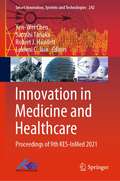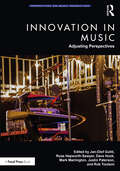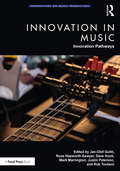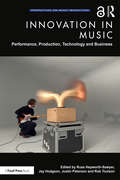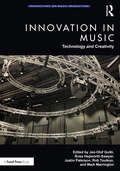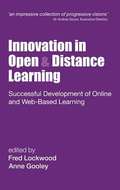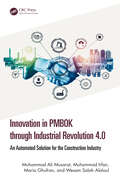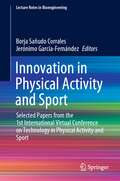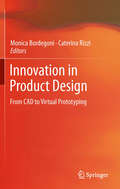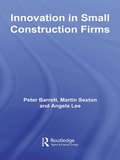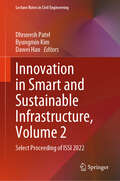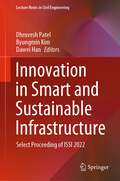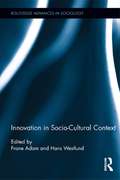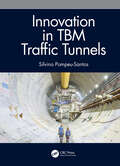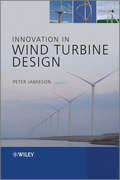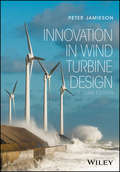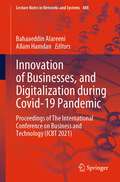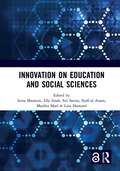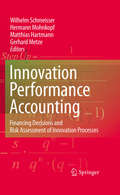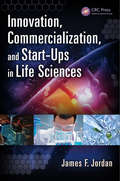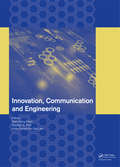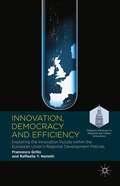- Table View
- List View
Innovation in Medicine and Healthcare: Proceedings of 9th KES-InMed 2021 (Smart Innovation, Systems and Technologies #242)
by Lakhmi C. Jain Robert J. Howlett Yen-Wei Chen Satoshi TanakaThis book presents the proceedings of the KES International Conferences on Innovation in Medicine and Healthcare (KES-InMed-21), held virtually on June 14–16, 2021. Covering a number of key areas, including digital IT architecture in healthcare; advanced ICT for medicine and healthcare; biomedical engineering, trends, research and technologies; and healthcare support systems, this book is a valuable resource for researchers, managers, industrialists and anyone wishing to gain an overview of the latest research in these fields.
Innovation in Music: Adjusting Perspectives (Perspectives on Music Production)
by Russ Hepworth-Sawyer Mark Marrington Justin Paterson Rob Toulson Jan-Olof Gullö Dave HookInnovation in Music: Adjusting Perspectives brings together cutting-edge research on new innovations in the field of music production, technology, performance, and business. With contributions from a host of well-respected researchers and practitioners, this volume provides crucial coverage on the relationship between innovation and rebellion.Including chapters on generative AI, gender equality, live music, quantisation, and composition, this book is recommended reading for music industry researchers working in a range of fields, as well as professionals interested in industry innovations.
Innovation in Music: Innovation Pathways (Perspectives on Music Production)
by Russ Hepworth-Sawyer Mark Marrington Justin Paterson Rob Toulson Jan-Olof Gullö Dave HookInnovation in Music: Innovation Pathways brings together cutting-edge research on new innovations in the field of music production, technology, performance, and business. With contributions from a host of well-respected researchers and practitioners, this volume provides crucial coverage on the relationship between innovation and rebellion.Including chapters on mixing desks, digital ethics, soundscapes, immersive audio, and computer-assisted music, this book is recommended reading for music industry researchers working in a range of fields, as well as professionals interested in industry innovations.
Innovation in Music: Performance, Production, Technology, and Business (Perspectives on Music Production)
by Jay Hodgson Russ Hepworth-Sawyer Justin Paterson Rob ToulsonInnovation in Music: Performance, Production, Technology and Business is an exciting collection comprising of cutting-edge articles on a range of topics, presented under the main themes of artistry, technology, production and industry. Each chapter is written by a leader in the field and contains insights and discoveries not yet shared. Innovation in Music covers new developments in standard practice of sound design, engineering and acoustics. It also reaches into areas of innovation, both in technology and business practice, even into cross-discipline areas. This book is the perfect companion for professionals and researchers alike with an interest in the Music industry.
Innovation in Music: Technology and Creativity (ISSN)
by Russ Hepworth-Sawyer Mark Marrington Justin Paterson Rob Toulson Jan-Olof GullöInnovation in Music: Technology and Creativity is a groundbreaking collection bringing together contributions from instructors, researchers, and professionals. Split into two sections, covering composition and performance, and technology and innovation, this volume offers truly international perspectives on ever-evolving practices.Including chapters on audience interaction, dynamic music methods, AI, and live electronic performances, this is recommended reading for professionals, students, and researchers looking for global insights into the fields of music production, music business, and music technology.
Innovation in Open and Distance Learning: Successful Development of Online and Web-based Learning
by Fred Lockwood Anne GooleyOpen and distance education is now widespread, not just in the open universities of the world, but in all education and training sectors, from traditional campus universities to corporate training centers.With contributions from some of the world's leading practitioners in the field, this book draws together contemporary experience in the application of technology to distributed learning. It will be a valuable guide to all those implementing web-based learning. It provides a thought provoking appraisal of the strategies and processes for managing change in open and distance learning and offers a progressive vision for all those involved in this widespread discipline.
Innovation in PMBOK through Industrial Revolution 4.0: An Automated Solution for the Construction Industry
by Muhammad Irfan Wesam Salah Alaloul Muhammad Musarat Maria GhufranIn this textbook for upper-undergraduate and postgraduate students, Dr Ali and colleagues provide the reader with information on the effect of Industrial Revolution 4.0 on the construction industry, particularly regarding PMBOK knowledge areas.The authors furnish readers with an understanding of IR 4.0 and reasons for adopting it and provide an in-depth insight into the impact of IR 4.0 on technology and society, particularly in the construction industry. Further to this, they also compare traditional and IR 4.0 project manager’s competencies so that readers can develop their understanding of Project Management Knowledge areas and how IR 4.0 can be used to enhance these knowledge areas. The book is structured logically and sequentially to benefit even novice readers as they progress from basic to more advanced topics related to IR 4.0 and PMBOK. The final main chapter of this book provides an in-depth discussion of the enhancement of PMBOK knowledge areas using IR 4.0, including topics such as project integration management, IR 4.0 enhancements such as digitalization, and a conceptual framework for industry betterment. By the end of the book, readers will have the knowledge and skills to apply IR 4.0 techniques in their future careers in the construction industry.This book is an invaluable resource for students of construction engineering and management at upper-undergraduate and postgraduate levels and for existing industry professionals as part of their continuous professional development.
Innovation in Physical Activity and Sport: Selected Papers from the 1st International Virtual Conference on Technology in Physical Activity and Sport (Lecture Notes in Bioengineering)
by Jerónimo García-Fernández Borja Sañudo CorralesThis book reports on cutting-edge digital technologies and their applications in physical activity and sport. Gathering selected chapters from the 1st International Conference on Technology in Physical Activity and Sport, held virtually on November 24-27, 2020, from Seville, Spain, it offers a practice-oriented and evidence-based perspective on how technologies can be used for evaluation and control of different parameter relating to sport, physical activity, and health. It covers how digital technologies can be applied for training and monitoring purposes, and for improving athlete’s performance, how they influence sport habits in different populations, demonstrating their growing influence in sport businesses (such as fitness centers) and management, and provides new findings on the connection between physical activity and human health, suggesting some interesting directions for future studies. With a good balance of laboratory research and information relevant for professional trainers, this book will provide bioengineers, sport scientists, and physiotherapists with timely information and a multidisciplinary perspective on the use of digital technologies to improve fitness, wellbeing and health in different population groups.
Innovation in Product Design
by Monica Bordegoni Caterina RizziInnovation in Product Design gives an overview of the research fields and achievements in the development of methods and tools for product design and innovation. It presents contributions from experts in many different fields covering a variety of research topics related to product development and innovation. Product lifecycle management, knowledge management, product customization, topological optimization, product virtualization, systematic innovation, virtual humans, design and engineering, and rapid prototyping are the key research areas described in the book. It also details successful case studies developed with industrial companies. Innovation in Product Design is written for academic researchers, graduate students and professionals in product development disciplines who are interested in understanding how novel methodologies and technologies can make the product development process more efficient.
Innovation in Small Construction Firms (Spon Research)
by Peter Barrett Martin Sexton Angela LeeInnovation in Small Construction Firms promotes the benefits of innovation, and stimulate innovation capability within and between small and medium sized (SMEs) construction firms in an effort to bring in a new 'can innovate, should innovate, want to innovate' culture to the construction industry. Presenting new theoretical and practical insights and models grounded in descriptive case studies, the issues addressed include: what is the motivation to innovate? what is appropriate innovation? how can small construction firms create, manage and exploit innovation? what practice-based models, tools and techniques support the capability of small construction firms to innovate well? how does this fit in the context of leading international work in construction innovation? Findings are contextualised in the broader literature to make them of relevance to policy makers, practitioners and researchers interested in small, project-based firms in general.
Innovation in Small-Farm Agriculture: Improving Livelihoods and Sustainability
by Amitava RakshitInnovation in Small-Farm Agriculture: Improving Livelihoods and Sustainability is an invaluable resource focussing on the current state of knowledge and scientific advances about the complex and intertwined issues of innovation and how they relate to livelihood of small-scale farmers. This book exposes readers with a holistic overview on how agriculture is most associated with the development and transfer of technologies to farmers and their participation in research and development initiatives to improve the relevancy and usefulness of its outputs and innovation which is not well documented. The book offers comprehensive coverage of the most essential topics, including: Recent scientific advances on agricultural innovations for small farmers. Emphasizes on opportunities and constraints of techno-institutional paradigms. Highlight low-cost and eco-friendly interventions. Case studies on various innovations in agriculture spanning the different agricultural gamut.
Innovation in Smart and Sustainable Infrastructure, Volume 2: Select Proceeding of ISSI 2022 (Lecture Notes in Civil Engineering #485)
by Dawei Han Dhruvesh Patel Byungmin KimThis book presents select peer-reviewed proceedings of the International Conference on Innovation in Smart and Sustainable Infrastructure (ISSI2022). The contents focus on smart infrastructure and cites, construction and infrastructure project management, application of building information modelling, sustainable materials and methods for road construction, smart technologies, applications and services for transportation systems, remote sensing and GIS for water resources management, climate change and prediction analysis, model simulation and analysis, seismic engineering and soil dynamics, innovation geo-materials and geosynthetics, computational geotechnics, emerging technologies in smart mobility and transport planning, among others. This volume will be useful for researchers and professionals in civil engineering and allied fields.
Innovation in Smart and Sustainable Infrastructure: Select Proceeding of ISSI 2022 (Lecture Notes in Civil Engineering #364)
by Dawei Han Dhruvesh Patel Byungmin KimThis book presents select peer-reviewed proceedings of the International Conference on Innovation in Smart and Sustainable Infrastructure (ISSI2022). The contents focus on smart infrastructure and cites, construction and infrastructure project management, application of building information modelling, sustainable materials and methods for road construction, smart technologies, applications and services for transportation systems, remote sensing and GIS for water resources management, climate change and prediction analysis, model simulation and analysis, seismic engineering and soil dynamics, innovation geo-materials and geosynthetics, computational geotechnics, emerging technologies in smart mobility and transport planning, among others. This volume will be useful for researchers and professionals in civil engineering and allied fields.
Innovation in Socio-Cultural Context: Innovation In Socio-cultural Context (Routledge Advances in Sociology #84)
by Frane Adam Hans WestlundInnovation - the process of obtaining, understanding, applying, transforming, managing and transferring knowledge - is a result of human collaboration, but it has become an increasingly complex process, with a growing number of interacting parties involved. Lack of innovation is not necessarily caused by lack of technology or lack of will to innovate, but often by social and cultural forces that jeopardize the cognitive processes and prevent potential innovation. This book focuses on the rule of social capital in the process of innovation: the social networks and the norms; values and attitudes (such as trust) of the actors; social capital as both bonding and bridging links between actors; and social capital as a feature at all spatial levels, from the single inventor to the transnational corporation. Contributors from a wide variety of countries and disciplines explore the cultural framework of innovation through empirics, case studies and examination of conceptual and methodological dilemmas.
Innovation in TBM Traffic Tunnels
by Silvino Pompeu-SantosTunnel Boring Machine (TBM) constructed tunnels are widespread, and can deliver significant environmental and cost benefits. However, as noted in the noteworthy examples of TBM traffic tunnels presented in this book, there are still important challenges associated with them, linked in particular to structural safety in the event of earthquakes, as well as cost and safety issues during operation. To face these challenges, Innovation in TBM Traffic Tunnels presents three innovative concepts in the field of construction of TBM rail and road tunnels: the TISB concept that improves the structural safety of those built on soft soil in seismic areas, and the TMG and TMF concepts, for rail and road tunnels, respectively, that allow for significant reduction of their cost and the improvement of safety during operation. Examples of the application of these new concepts in the conceptual design of specific tunnel cases are presented and compared with solutions based on common approaches, demonstrating the additional benefits of these concepts. The book also draws attention to other innovations in TBM tunnelling that may improve the construction of tunnels in the future, especially when using the concepts mentioned above. Innovation in TBM Traffic Tunnels is aimed at professionals involved in the planning, design, and construction of tunnels for transport infrastructure, including authorities, consultants and construction companies, worldwide.
Innovation in Wind Turbine Design
by Peter JamiesonInnovation in Wind Turbine Design addresses the fundamentals of design, the reasons behind design choices, and describes the methodology for evaluating innovative systems and components. Always referencing a state of the art system for comparison, Jamieson discusses the basics of wind turbine theory and design, as well as how to apply existing engineering knowledge to further advance the technology, enabling the reader to gain a thorough understanding of current technology before assessing where it can go in the future.Innovation in Wind Turbine Design is divided into four main sections covering design background, technology evaluation, design themes and innovative technology examples:Section 1 reviews aerodynamic theory and the optimization of rotor design, discusses wind energy conversion systems, drive trains, scaling issues, offshore wind turbines, and concludes with an overview of technology trends with a glimpse of possible future technologySection 2 comprises a global view of the multitude of design options for wind turbine systems and develops evaluation methodology, including cost of energy assessment with some specific examplesSection 3 discusses recurrent design themes such as blade number, pitch or stall, horizontal or vertical axisSection 4 considers examples of innovative technology with case studies from real-life commercial clients.This groundbreaking synopsis of the state of the art in wind turbine design is must-have reading for professional wind engineers, power engineers and turbine designers, as well as consultants, researchers and academics working in renewable energy.
Innovation in Wind Turbine Design
by Peter JamiesonAn updated and expanded new edition of this comprehensive guide to innovation in wind turbine design Innovation in Wind Turbine Design, Second Edition comprehensively covers the fundamentals of design, explains the reasons behind design choices, and describes the methodology for evaluating innovative systems and components. This second edition has been substantially expanded and generally updated. New content includes elementary actuator disc theory of the low induction rotor concept, much expanded discussion of offshore issues and of airborne wind energy systems, updated drive train information with basic theory of the epicyclic gears and differential drives, a clarified presentation of the basic theory of energy in the wind and fallacies about ducted rotor design related to theory, lab testing and field testing of the Katru and Wind Lens ducted rotor systems, a short review of LiDAR, latest developments of the multi-rotor concept including the Vestas 4 rotor system and a new chapter on the innovative DeepWind VAWT. The bookis divided into four main sections covering design background, technology evaluation, design themes and innovative technology examples. Key features: Expanded substantially with new content. Comprehensively covers the fundamentals of design, explains the reasons behind design choices, and describes the methodology for evaluating innovative systems and components. Includes innovative examples from working experiences for commercial clients. Updated to cover recent developments in the field. The book is a must-have reference for professional wind engineers, power engineers and turbine designers, as well as consultants, researchers and graduate students.
Innovation of Businesses, and Digitalization during Covid-19 Pandemic: Proceedings of The International Conference on Business and Technology (ICBT 2021) (Lecture Notes in Networks and Systems #488)
by Allam Hamdan Bahaaeddin AlareeniThis book constitutes the refereed proceedings of the International Conference on Business and Technology (ICBT2021) organized by EuroMid Academy of Business & Technology (EMABT), held in Istanbul, between 06–07 November 2021. In response to the call for papers for ICBT2021, 485 papers were submitted for presentation and inclusion in the proceedings of the conference. After a careful blind refereeing process, 292 papers were selected for inclusion in the conference proceedings from forty countries. Each of these chapters was evaluated through an editorial board, and each chapter was passed through a double-blind peer-review process.The book highlights a range of topics in the fields of technology, entrepreneurship, business administration, accounting, and economics that can contribute to business development in countries, such as learning machines, artificial intelligence, big data, deep learning, game-based learning, management information system, accounting information system, knowledge management, entrepreneurship, and social enterprise, corporate social responsibility and sustainability, business policy and strategic management, international management and organizations, organizational behavior and HRM, operations management and logistics research, controversial issues in management and organizations, turnaround, corporate entrepreneurship, innovation, legal issues, business ethics, and firm gerial accounting and firm financial affairs, non-traditional research, and creative methodologies.These proceedings are reflecting quality research contributing theoretical and practical implications, for those who are wise to apply the technology within any business sector. It is our hope that the contribution of this book proceedings will be of the academic level which even decision-makers in the various economic and executive-level will get to appreciate.
Innovation on Demand
by Victor Fey Eugene RivinThe revolutionary methodology for enhancing technological innovation called TRIZ is increasingly being adopted by leading corporations around the world to enhance their competitive position. This book explains how the TRIZ methodology harnesses creative principles extracted from thousands of successful patented inventions to help find more innovative solutions to design problems. Written for practicing engineers, product managers, technology managers and engineering students, it demonstrates how to use TRIZ tools for conceptual development of novel technologies, products and manufacturing processes.
Innovation on Education and Social Sciences: Proceedings of the International Joint Conference on Arts and Humanities (IJCAH 2021) October 2, 2021, Surabaya, Indonesia
by Irena MaureenAfter a year of a global Covid-19 pandemic, still, we have more questions than answers to the future of education and our social life. It is more important than ever to follow the developments closely in the coming period, pay attention to critical concerns such as inequality, as well as positive signs of transformation and innovation in all aspects of the world of teaching and learning. Expectations on what the future brings will have to be based on solid research rather than short-term perceptions. The proceedings of IJCAH 2021 are an interdisciplinary platform for teachers, researchers, practitioners, and academicians to discuss the latest research findings, concerns, and practical challenges encountered and solutions adopted in the fields of Arts and Humanities. The subject areas within the proceeding are education, language learning, arts, culture, social sciences.
Innovation performance accounting
by Matthias Hartmann Hermann Mohnkopf Gerhard Metze Wilhelm SchmeisserFor successful innovation in business the responsible managers need a consistent view of the individual processes as well as an assessment of key projects in all phases of the development. Generating new ideas, fast examination of its feasibility requires skilled methods for evaluation of these ideas, plans and especially costs and revenues. Business models, calculation methods and some assessments of certain options are presented by the authors. The ability to identify risks and appropriate responses to misperceptions are important milestones in the innovation process. From analysis of problems to the introduction of market-ready solutions, legal requirements, business demands and risk management systems are discussed. Concepts promoting uniform, binding rules for ratings in the innovation process are treated. The identification of target pricing, target costing and litigation, the evaluation of the solution to calculate risk aspects as tasks in financial management and innovation controlling are part of the content. The authors demonstrate that any innovation in different industries requires a strategic and financial project management. Monetary assessment of the individual processes, a detailed patent portfolio and accounts management for innovation processes are of enormous importance. The book is completed by applications of the Berlin Balanced Scorecard Concept with practical examples from the innovation projects in pharmaceutical and technical business.
Innovation, Commercialization, and Start-Ups in Life Sciences
by James F. JordanInnovation is the translation of a new method, idea, or product into reality and profit. It is a process of connected steps that accumulates into your brand or reputation. However, there can be many pitfalls and wrong turns on the road to realizing this goal. Innovation, Commercialization, and Start-Ups in Life Sciences details the methodologies ne
Innovation, Commercialization, and Start-Ups in Life Sciences
by James F. JordanInnovation is a translation of a new method, idea, or product into reality and profit. It is a process of connected steps that accumulates into a brand reputation required for success. Unlike Fortune 500 companies, whose projects are self-funded, a start-up must simultaneously have a value proposition that attracts a customer (for revenue), investors (for capital), and acquirers (for a liquidity event or IPO). A high percentage of start-ups fail before attaining positive cashflow, due to a variety of reasons that are detailed in this book.Avoiding the pitfalls and wrong turns are the goals of this book. Innovation, Commercialization, and Start-Ups in Life Sciences details the methodologies necessary to create a successful life science start-up from initiation to exit. Written by an expert who has worked with more nearly 500 life science start-ups, this book discusses specific processes and investor milestones that must be navigated to align customer, funder, and acquirer needs. Successful commercialization requires attention to multiple constituents, such as investors, regulators, and customers. Investors require liquidity for their return, which is achieved through selling their stock in a public or private sale. The reader will gain an appreciation for the necessary data, partnerships, and skills needed to create a competitive and sustainable company. The author discusses such specific issues as customer problems, demonstrating sales access, and ensuring intellectual property is impervious to competitive advancement. This book is intended to be suitable for entrepreneurs, venture capitalists, and investors in both business and academic settings. These organizations have specific departments, such as R&D, operations, business development, legal, regulatory, and marketing, that would also benefit from this book.FEATURES Focuses specifically on life science start-ups Examines how to determine a company valuation and future "fundable milestones" Explores how to align regulatory and clinical strategies Discusses intellectual property derived from a university or individual through formation to exit. Reviews how start‐ups must simultaneously meet the needs of multiple constituencies at once: investors, regulators, customers and exit candidates James F. Jordan is an author, consultant, and speaker. He is a Distinguished Service Professor of Healthcare & Biotechnology Management, a former Fortune 100 executive, and a managing director of a venture fund.Access the Support Material: https://healthcaredata.center/ Cover design by Sarah Mailhott.
Innovation, Communication and Engineering
by Stephen D. Prior Teen-Hang Meen Artde Donald Kin-Tak LamThis volume represents the proceedings of the 2013 International Conference on Innovation, Communication and Engineering (ICICE 2013). This conference was organized by the China University of Petroleum (Huadong/East China) and the Taiwanese Institute of Knowledge Innovation, and was held in Qingdao, Shandong, P.R. China, October 26 - November 1, 20
